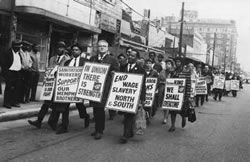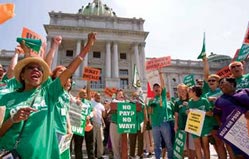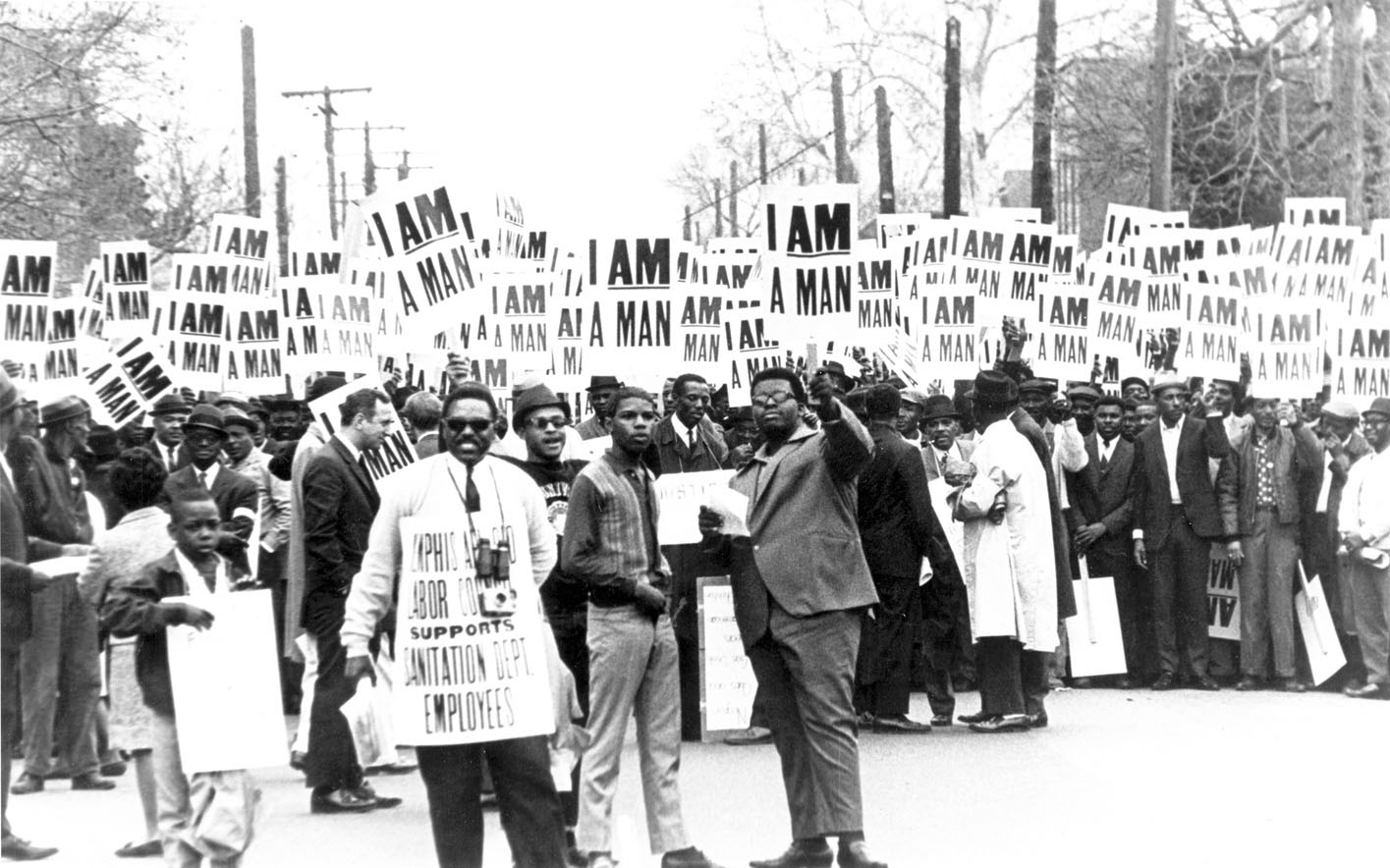AFSCME was founded during the Great Depression on a simple idea – that a professional civil service is essential to a strong democracy. The business of the people should be carried out by individuals dedicated to serving their communities, not those who have close connections to politicians. This idea has sustained AFSCME through nearly nine decades, as it has grown from a fledgling organization of a few thousand people to one of the most potent forces in the labor movement.
Fighting for Civil Service

1932
A small group of white-collar professional employees in Madison, Wis., fearing they would lose their civil service jobs to political patronage, formed the Wisconsin State Employees Association (WSEA), which would later become Council 24 (Wisconsin State Employees Union).
1933
WSEA members held meetings, marched, demonstrated and lobbied hard in the state Legislature to defeat a bill that would have dismantled the state civil service system.
1935
Similar employee associations emerged in 19 states; at the American Federation of Labor (AFL) convention, the group, now known as the American Federation of State, County and Municipal Employees (AFSCME), was made a “department” of the American Federation of Government Employees (AFGE).
1936
AFSCME was granted a charter by the AFL; Arnold Zander was chosen as AFSCME’s first International president after he formed a coalition of 20 public sector locals around the country.
1938
2,000 sanitation workers in Philadelphia went on strike to protest layoffs and pay cuts and won AFSCME’s first bargaining agreement with a major city.
1936-45
AFSCME focused on lobbying in state legislatures to pass or strengthen civil service laws; membership increased from 10,000 to 73,000.
1945-46
World War II ended; the postwar period was marked by a wave of strikes as workers — 3.5 million in 1945 and 4.6 million in 1946 — struck for higher wages in the postwar economy; there was also unrest in the public sector as city employees struck in several cities.
1947
Eight states passed laws that would penalize striking public workers; Congress passed the Taft-Hartley Act, which restricted private-sector unions and made it easier for employers to break strikes.
1955
AFL and CIO (Congress of Industrial Organizations) merged to form the AFL-CIO; AFSCME membership passed 100,000.
Bargaining for Rights
1958
A series of strikes and demonstrations in New York City pressured Mayor Robert Wagner to sign an executive order granting collective bargaining rights to unions representing city employees; under the leadership of District Council 37 President Jerry Wurf, AFSCME began winning elections that made it the strongest public worker union in the city.
1961
President John Kennedy issued Executive Order 10988, legitimizing collective bargaining for federal employees and creating a favorable atmosphere for all public employees.
1964
Jerry Wurf — running on a platform of aggressive organizing, fighting for collective bargaining rights for public workers, and union reform/union democracy — was elected the second International president at the biennial AFSCME Convention.
1965
A special AFSCME Convention rewrote AFSCME’s Constitution and included a Bill of Rights for union members, a first in the American labor movement.
By year’s end, several states enacted collective bargaining laws for public employees; AFSCME membership reached 250,000.
Militant Demands for Respect
Mid 1960s
More states passed collective bargaining laws; AFSCME’s demands for respect for public workers became linked with the civil rights movement and progressive groups that protested economic, racial and social injustice.
1968
Sanitation workers in Memphis, Tenn., struck for union recognition and against the city’s discriminatory practices; Dr. Martin Luther King Jr., marched with the striking workers and was assassinated; the city agreed to recognize the workers’ union, AFSCME Local 1733.
1972
William Lucy was elected secretary-treasurer of the International union; a lifelong civil rights activist, Lucy worked closely with Dr. Martin Luther King, Jr. in Memphis, Tenn. and led labor’s delegation to South Africa after the election of President Nelson Mandela.
1975
In Pennsylvania, some 46,000 AFSCME-represented state workers struck for fair wages — the first legal, large-scale strike by public employees.
Power Through Organizing and Political Action
Mid 1970s
Over 60 independent employee associations affiliated with AFSCME.
1978
The New York Civil Service Employees Association (CSEA), with 250,000 members, affiliated with AFSCME and pushed membership over the 1 million mark.
1980s
In an era of anti-public worker sentiment, AFSCME greatly increased its political activism and visibility and helped elect AFSCME-endorsed candidates at all government levels; collective bargaining rights were won in three new states: Illinois, Ohio and Nebraska.
1981
President Ronald Reagan broke a strike by PATCO (Professional Air Traffic Controllers Organization), beginning an era of attacks on workers in both the public and private sectors.
AFSCME’s 60,000-member delegation, the largest from any single union, led the AFL-CIO Solidarity Day — a massive demonstration in Washington, DC, demanding fair treatment for American workers.
City workers in San Jose, Calif., members of AFSCME Local 101, waged the first strike in the nation’s history over the issue of pay equity for women workers.
AFSCME President Jerry Wurf died. Following his death, union members and friends created the Wurf Memorial Fund to honor his life and legacy. It provides support for research, scholarship and leadership development to promote public sector unionism and strengthen union leaders’ capacity to meet 21st century challenges.
Gerald McEntee was chosen as the union’s third International president. He began his AFSCME career in 1958 as a member and continued as an organizer and leader in Pennsylvania. He led the drive to unionize more than 75,000 public service workers in Pennsylvania — the largest union mobilization in the United States at that time.
1989
The National Union of Hospital and Health Care Employees (NUHHCE) affiliated with AFSCME and solidified the union as the leading voice for the rights of health care workers.
1990
AFSCME membership surpassed 1.2 million.
1998
Delegates at AFSCME’s Convention committed to a bold program of aggressive organizing.
AFSCME in the 21st Century

2001
60,000 public service workers in a dozen states and Puerto Rico organized with AFSCME — the largest single year of organizing in three decades.
2002
Another 55,000 workers joined AFSCME; membership reached 1.3 million.
2004
AFSCME Convention delegates passed the 21st Century Resolution, creating a committee to examine every aspect of the union and to make recommendations to the 2006 AFSCME Convention.
2006
AFSCME increased its ranks to 1.6 million members.
The 21st Century Power to Win plan was adopted at the 37th AFSCME International Convention, and delegates participated in a town hall meeting to discuss implementation of the plan.
Due to grassroots efforts across the country, AFSCME helped stop the Bush administration from privatizing Social Security.
Through concerted efforts, the union helped win six governors’ houses and took back legislative chambers in 10 states, and won back the U.S. House of Representatives and the U.S. Congress.
2007
The union created a new brand and identity which included the new logo and tagline: We Make America Happen.
2008
40,000 volunteers mobilized to elect President Barack Obama and Vice President Joe Biden.
2009
AFSCME was the top organizing union in the AFL-CIO.
AFSCME played a major role in winning health care reform and getting fiscal relief for states through the American Reinvestment and Recovery Act (ARRA).
AFSCME convened the first-ever national Next Wave Conference, for new and young leaders of local unions and councils. Close to 600 Next Wavers converged on Chicago, Illinois.
2010
Lee A. Saunders was elected International secretary-treasurer in July at the International Convention. Saunders joined the Ohio Civil Service Employees Association (OCSEA) when he worked for the state of Ohio in his 20s. Saunders had worked for AFSCME in many capacities since 1978, most recently as executive assistant to AFSCME President Gerald McEntee. In that role, he was responsible for managing the most effective political and legislative operation in the history of the American labor movement.
2011
In February 2011, nearly 200,000 Wisconsin public service employees, including more than 60,000 AFSCME members, lost the right to bargain collectively over health care, retirement and working conditions. In response, tens of thousands of protestors demonstrated at the Capitol in Madison for months. A recall campaign was mounted that ultimately resulted in two Republican state senators being unseated from office.
In Ohio, Senate Bill 5 (SB 5) targeted collective bargaining for public workers. AFSCME members, working with other unions and coalition partners, gathered enough signatures to place a repeal referendum on Ohio’s November 2011 ballot. Ohioans overwhelmingly voted to repeal SB 5 and to protect collective bargaining for public employees.
2012
Lee A. Saunders was elected International president in June at the International Convention, becoming the union’s first African American president. Saunders succeeded Gerald McEntee, who served the union as president for more than 30 years and oversaw AFSCME’s growth in membership and political power. Under Saunders’ leadership, the union engaged in its largest electoral mobilization ever to reelect President Barack Obama.
The right-wing assault on workers’ rights continued, as anti-union politicians in Indiana and Michigan enacted right-to-work laws intended to weaken union power.
2013
AFSCME continued to aggressively organize new members, adding thousands of emergency medical services workers and 7,500 Vermont home care providers, who later won raises of up to 30% in their first contract.
2014
AFSCME initiated the 50,000 Stronger program to organize new members, relying in large part on volunteer member organizers, or VMOs. The International Union and affiliates not only met that goal, but nearly doubled it — adding 92,155 members by the time of the International Convention in July.
2015
President Saunders initiated AFSCME Strong, a comprehensive expansion of the 50,000 Stronger campaign to strengthen the union in the workplace and add new members, in order to overcome attacks from anti-union billionaires and politicians.
2016
President Saunders was reelected at the 42nd International Convention. A New York Times profile that summer highlighted the change AFSCME Strong represents, calling it an “ambitious undertaking” that is “already paying dividends,” crediting President Saunders for his “attention to the [AFSCME] rank and file.”
By an overwhelming margin, workers from Public Employees Union, Local 1, in Northern California voted to affiliate with AFSCME, adding more than 6,500 new members.
2017
Republicans assumed full control of the legislature and governor’s office in Iowa and quickly went about eliminating collective bargaining rights for public employees. House File 291 sharply limited the scope of what AFSCME and other unions can bargain over and required biased elections to recertify unions that count those who don’t vote as “no” votes. Nevertheless, Iowa public workers have voted by more than 90% margins to keep their union.
Elissa McBride became secretary-treasurer of AFSCME. McBride has served the labor movement for three decades as a member, organizer, trainer and leader. From 2001 to 2017, she was the director of AFSCME’s Education and Leadership Department.
2018
Thousands gathered in Memphis to mark the 50th anniversary of the 1968 Sanitation Workers’ Strike and the assassination of Dr. Martin Luther King Jr., who was in the city to support the workers, leading a call to action for economic and social justice for all working people.
The U.S. Supreme Court, in a partisan 5-4 decision in Janus v. AFSCME Council 31, overturned a four-decade precedent, ruling that public sector workers covered by collective bargaining agreements can avoid paying their fair share of the cost of union representation. The Janus case, funded by wealthy corporate special interests, is an attack on the freedom of working people, the culmination of a decades-long orchestrated campaign to destroy the power of unions. But because of the groundwork laid by the AFSCME Strong campaign, the union retained 94 percent of the workers it represented and experienced growth of more than 9,000 dues-paying members and 18,000 dues-paying retirees over the previous year.
2019
AFSCME continued to expand the rights of public service workers by securing collective bargaining for 40,000 family child care providers in California and 20,000 state employees in Nevada, the largest expansion of collective bargaining rights for state workers anywhere in the country in 16 years.
The Pandemic and its Aftermath
2020
As the COVID-19 pandemic spread rapidly in 2020, essential workers put their lives on the line by working in person on the front lines to serve their communities.
AFSCME launched Fund the Front Lines (FTFL), a campaign to urge Congress to approve emergency funding for state and local governments.
AFSCME also launched the Cultural Workers United (CWU) campaign to organize workers in libraries, museums, zoos and more.
AFSCME members played a key role in electing Joe Biden and Kamala Harris to the White House.
AFSCME led a campaign to expand collective bargaining rights to thousands of public service workers in Virginia. The legislation striking down that ban was sponsored by an AFSCME member serving in the General Assembly.
2021
In 2021, our union’s Fund the Front Lines campaign was successful as President Biden’s American Rescue Plan Act included $350 billion in aid to state and local governments and schools. AFSCME members, who contacted their members of Congress by the thousands, played a key role in passing the bill.
2022
AFSCME members led the push in Colorado to expand collective bargaining rights for county workers. Colorado enacted a law allowing up to 36,000 county workers to form unions. Prior to that law, workers for just four of Colorado’s 64 counties had collective bargaining rights.
2023
To resolve the public service worker staffing crisis, AFSCME launched the Staff the Front Lines (STFL) campaign. STFL included a national bus tour to urge state and local leaders to increase public service staffing. AFSCME members worked with governors, mayors and city council members to recruit qualified people to work in public service.
Thanks to funds from the American Rescue Plan, public service workers were also able to negotiate historic contracts with record pay raises.
Working People Under Attack
2025
As Donald Trump returned to the White House, billionaires and anti-union extremists orchestrated mass firings of federal workers, set out to destroy public services, and attacked labor unions.
To fight back, AFSCME launched the Get Organized (GO) campaign.
AFSCME members organized to protect public services as well as lifesaving programs such as Medicare, Medicaid and Social Security. AFSCME filed multiple lawsuits to fight the administration’s illegal overreach.
After the so-called “One Big Beautiful Bill Act” passed Congress by a razor-thin margin, AFSCME members spoke out at events nationwide, holding members of Congress accountable for their votes.
CWU reached a milestone — organizing 50,000 cultural workers across the country, more than any other union.
